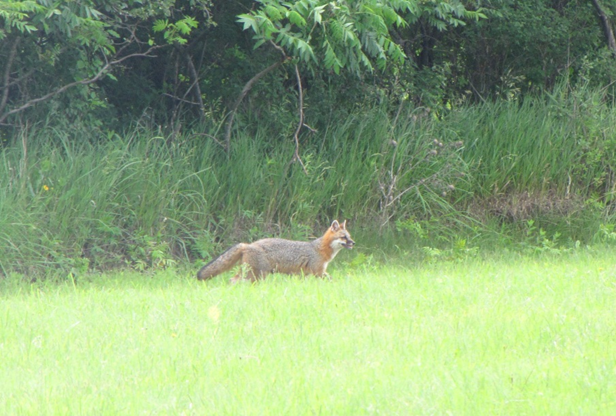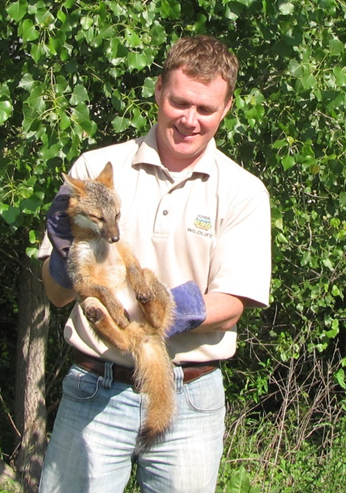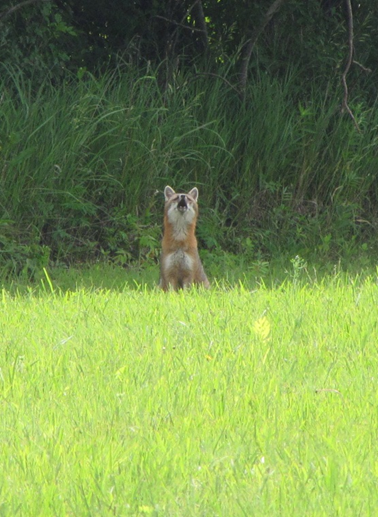
(Photo/Vince Evelsizer, Iowa Department of Natural Resources)
The Iowa Department of Natural Resources has started a research project to determine the reason behind the state’s gray fox population decline.
Vince Evelsizer, furbearer biologist with the Iowa DNR, said exact numbers are unknown, due to the secretive nature of the gray fox.
“Based on past annual harvest records and a lack of detection in a couple of our annual statewide wildlife surveys, plus field reports, we estimate the gray fox population is 5 to 10 percent of what it was 25 years ago,” Evelsizer said, putting that number at just hundreds or fewer.

Vince Evelsizer, furbearer biologist with the Iowa Department of Natural Resources, is shown with a gray fox pup captured in Mason City. (photo/Dave Hoffman)
Part of the reason may be forest types that support rabbits, mice and other gray fox prey.
Evelsizer said mature, even-aged forest is fine for some aspects of the gray fox annual life cycle, but areas of younger — thick and bushy — forest supports more prey, and proper logging methods can stimulate young forest growth.
“We’re not saying folks should clear-cut their entire woodlands,” he said. “We’re saying that a little cutting here and there on the forest edges during the winter is an example of promoting young forest growth. Consulting a professional forester first is the best step before finding a logger.”
Read on to learn more about the research project, from the Iowa DNR:
The Iowa DNR is asking trappers for help with a study on Iowa’s gray fox population.
“We’re asking trappers who happen to catch a gray fox alive to contact me or wildlife technician Dave Hoffman directly so we can make arrangements to equip the animal with a neck collar and release it for tracking purposes as part of a research project. If they can’t reach us, another option is to contact their local wildlife biologist or conservation officer,” said Vince Evelsizer, furbearer biologist with the Iowa DNR.
Hoffman’s cell number is 641-425-0737; Evelsizer’s is 641-231-1522.
“Our gray fox population is down and we’re concerned. At this time, the cause for their population decline is unknown. We’re hoping this study will give us some data related to causes of mortality, habitat use, home ranges, etc., that we can begin to learn more about what is going on with this population.”
The gray fox population in Iowa and other Midwestern states has declined over the past 25 years. In Iowa, the population decline is correlated with increases in the population of coyotes, raccoons, and bobcats. Increasing coyote and bobcat populations may affect gray fox populations through competition and predation. Raccoons may impact gray fox populations through the spread of disease, particularly canine distemper virus. Canine distemper is common in raccoons, and gray fox are highly susceptible to this lethal disease.

Changes in Iowa’s forest habitat may also contribute to lower gray fox numbers. Mature, even-aged forests don’t support the prey base needed for gray fox. A combination of these factors, as well as potential other unknown factors, may have contributed to their decline.
(photo/Vince Evelsizer, Iowa Department of Natural Resources)
Evelsizer said they are offering a $400 reward as an incentive for live-caught foxes that are healthy and used for the study.
Gray fox can be found statewide, but their core area is eastern and southern Iowa, in forested habitats, like cedar thickets, deciduous forests, the driftless region, on old farms and overgrown pastures.
They are smaller than the red fox with adults weighing up to 12 pounds. They have a seasonal diet feeding on birds and rodents, but eat young grasses in the spring, grasshoppers, crickets, mulberries, raspberries in the summer and wild plums, grapes, apples and pears in the fall. They are also capable of climbing trees, which is a unique feature for a member of the canine family.

[…] More from the DNR: Iowa studies plummet in gray fox population […]